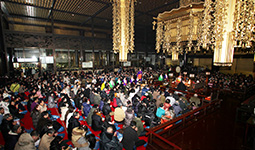Home > Highlighting JAPAN > Highlighting Japan January 2020 > Winter Pleasures
Highlighting JAPAN


Prayers for the New Year
At the beginning of the new year, the grounds of shrines and temples around Japan are crowded with people making the customary hatsumode “first visit” to offer prayers.
Hatsumode is the practice of making a “first visit” to a shrine or temple in the new year, to pray for such things as the safety of one’s family, academic achievements or prosperity in business. Temples and shrines, which are usually peaceful places, come alive at this time with people making their hatsumode visit, which tradition dictates should be made during the first three days of the new year. Visitor numbers also grow at this time because many people stay at their parents’ homes during the New Year holiday and visit their local temple or shrine with family members.
When visiting a shrine or temple in the new year, some people get wooden plaques called ema, write their wishes on them and hang them up. Others receive hamaya, decorative arrows said to protect against evil spirits, or other types of good luck charms. Almost everyone is sure to draw an omikuji, fortune-telling slips spelling out the type of luck a person can expect in the year ahead. Many people enjoy celebrating the new year at a shrine or temple with family and friends, and together pray that they will live safe and happy lives throughout the new year.
Hatsumode as it is practiced today became popular in the Meiji period (1868–1912) following the birth of the railways. Previously, people had paid homage at the shrine or temple closest to them in the year’s lucky eho direction, a practice known as ehomairi. When Japan’s first railway service commenced in 1872 between Shimbashi in Tokyo and Yokohama, and a station was built on the line near the Kawasaki Daishi Heikenji Temple, a popular place of worship for many years, people began to visit the temple by train, whether it was located in the eho direction or not. After the railway network expanded nationwide, more and more people started to visit famous shrines and temples as well as those located nearby, thereby establishing today’s style of worship.
A typical example is a visit to Naritasan Shinsho-ji Temple in Narita City, Chiba Prefecture. Naritasan, which was founded in 940, is a Buddhist temple of the Shingon school opened by Kukai (774–835), also known as Kobo Daishi, or Great Teacher. The temple houses a statue of the Fudo-myo-o deity. Naritasan became widely known in the Edo period (1603–1867) owing to the popularity of a kabuki play featuring the Fudo-myo-o performed by Ichikawa Danjuro the First, an actor who strongly believed in Naritasan’s Fudo-myo-o.
In those days, it took four days on foot to get to Naritasan from Edo, present-day Tokyo. After the railway service was opened between Tokyo and Narita in 1897, however, day-trips became possible. In the New Year, the railway operator began to lay on special trains for the purpose of carrying people to Naritasan from Tokyo for hatsumode, further increasing the number of visitors. In recent years, the number of visitors to Naritasan during the first three days of the new year has exceeded three million, making the temple as popular as Meiji Jingu shrine in Tokyo and one of the shrines and temples that attracts the largest number of worshippers in Japan. Being located close to Narita International Airport, the temple also attracts visitors from abroad.
As the end of a year approaches, Naritasan enters hatsumode mode. In November, workers begin creating the Oshimenawa, a huge rope measuring 6.6 meters long and weighing more than 200 kilograms, by bundling dry straw taken from paddy fields in Narita City. The Oshimenawa, the creation of which is said to originate from prayers for a rich harvest beginning in the Genroku era (1688–1704) of the Edo period, is displayed at the front gate of the Dai Hondo, the temple’s main hall, in late December. Monks and temple staff also undertake a large-scale cleaning ritual at this time called susuharai. They remove dust from the statue of the Fudo-myo-o using brushes made of horsehair and sweep soot from the main hall using long bamboo brooms. Preparations are completed in time for New Year’s Eve and the arrival of the first hatsumode visitors of the new year. Train services are adjusted to help assist people traveling from Tokyo to Narita at night.
“Many people gather here at midnight on New Year’s Eve,” says Nakamine Shoki, a staff member in the planning department of Naritasan. “After daybreak, with more people coming to worship, the temple grounds are filled with people, and the waiting lines of visitors extend along the front approach.”
At temples in Japan, the Joya no kane bells of New Year’s Eve are rung 108 times from midnight to eliminate each of the 108 earthly desires that human beings are thought to harbor. At Naritasan, while the bell is ringing, the Gancho Ogomaku ceremony, a large-scale memorial service, is carried out in the main hall. Priests at Naritasan have been conducting the Gomakito fire ceremony, in which special firewood called Gomaki is burned in front of the Fudo-myo-o and monks offer prayers, for more than 1,000 years. The Gancho Ogomaku ceremony is the first fire ceremony carried out at the beginning of each new year. While monks recite a sutra, worshippers offer prayers in front of the flames and solemnly mark the arrival of the new year.
The practice of offering New Year’s prayers has changed with the times, from the ehomairi of the Edo period to the hatsumode of today, but what people pray for has remained unchanged.
© 2009 Cabinet Office, Government of Japan







